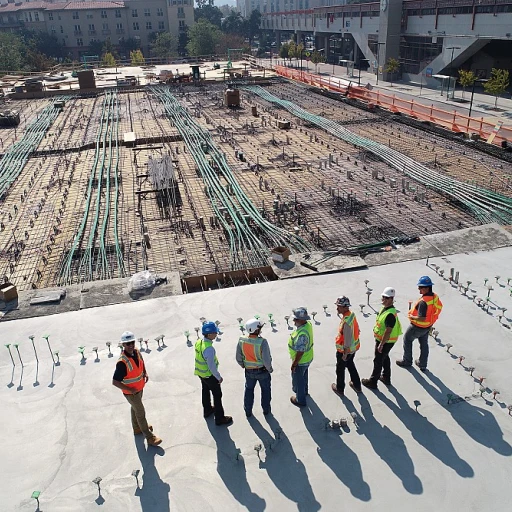
Understanding the Core HR Processes
Unpacking Essential HR Functions
To truly optimize HR processes for strategic leadership, one must first understand the core human resources (HR) functions that form the backbone of any organization. At their essence, these processes involve a series of actions centered around managing employees and ensuring an effective and harmonious work environment. A robust understanding of these foundational elements aids leaders in guiding their human capital and aligns employee management with overarching business objectives. Key HR processes include employee onboarding and offboarding, compensation benefits, and resource management. A seamless employee onboarding experience is crucial as it sets the tone for employee engagement and company culture. Equally important are performance management and training development, critical in nurturing an environment where employees can thrive. Performance management helps track employee performance, aligning individual contributions with the company’s goals. Meanwhile, training development ensures employees are well-equipped with the necessary skills and knowledge to perform their roles effectively, enhancing the overall productivity. Employee relations and employee experience are also integral core processes, often involving conflict resolution and feedback systems to foster a positive workplace atmosphere. These practices not only aid in boosting morale but also in retaining top talent by addressing employee concerns promptly and effectively. However, managing these processes efficiently requires time, effort, and a keen understanding of the organization’s needs. Process automation can significantly streamline these functions, freeing up valuable company resources for more strategic initiatives. The challenge lies in the ability of HR leaders to balance traditional processes with emerging technologies, leveraging data and automation software for more informed decision making. By gaining a comprehensive understanding of these core HR practices, a chief human resources officer (CHRO) can take significant steps towards enhancing human resource management within their organization. For insights into enhancing HR leadership, read more on harnessing dynamic leadership in the CHRO role.The Role of a CHRO in Streamlining HR Processes
Driving Efficiency in Human Resources
Streamlining core HR processes is crucial in optimizing the efficiency and effectiveness of any organization. A Chief Human Resources Officer (CHRO) plays a pivotal role in aligning these processes with the organization's strategic goals. With the increasing complexity of employee management and the rising importance of employee experience, the CHRO's responsibilities have expanded to focus not only on traditional resource management but also on innovative solutions for process optimization. The CHRO works diligently to simplify processes like employee onboarding and offboarding, ensuring a seamless transition and integration for new employees. By prioritizing efficient onboarding, the company culture and employee engagement levels can be significantly enhanced. Effective onboarding also involves continuous employee training and development initiatives and thus contributes to better employee performance and retention rates. Another critical area for the CHRO is optimizing compensation and benefits management. By streamlining these processes, the CHRO ensures that employees feel valued and rewarded, contributing positively to employee relations and overall satisfaction. Thoughtful decision making and reliance on performance management data are essential in reshaping these compensation strategies. Incorporating process automation advancements is another call of the hour, with technology providing tools to reduce manual tasks and administrative burdens. This integration aids in shifting focus toward more strategic human resource activities, thereby improving overall productivity and cost-efficiency. Ultimately, the overarching goal of the CHRO is to foster a work environment where effective resource management aligns with the company's objectives. This alignment can drive business growth and ensure sustainability in dynamic market conditions. For further insights into the strategic role of a CHRO, explore this blog on strategic planning.Leveraging Technology in HR Processes
Unlocking the Potential of Technology in HR
In today's fast-paced business environment, leveraging technology within HR processes is no longer optional—it's essential for maintaining competitive edge and enhancing employee experience. With the integration of cutting-edge automation software, many organizations have streamlined their core processes, significantly saving time and improving overall efficiency. The transition towards automation in HR allows for seamless onboarding and offboarding, ensuring that employees have a smooth entry into and exit from the company. Automation reduces human error and ensures that the necessary steps, such as paperwork, training development, and employee engagement activities, are not overlooked. Moreover, sophisticated data management systems enable better process management, allowing HR professionals to focus on strategic human resource tasks rather than routine administrative work. These systems provide valuable insights into workforce planning and employee performance, thereby aiding in informed decision making. Analytical tools can uncover trends in employee relations and compensation benefits, ultimately helping tailor initiatives that foster a positive company culture. There's also a growing emphasis on integrating performance management and training development tools into HR software. These advancements allow for real-time tracking of employee performance, which is crucial for identifying skills gaps and planning future training initiatives. Automation helps ensure that your team can focus on human-centric tasks that drive real business change, thus elevating the strategic importance of HR. Gone are the days when businesses relied solely on manual processes. Today's human resource leaders must champion technology adoption to optimize HR functions. To explore more about how HR transformation can be navigated by a CHRO, this resource offers valuable insights.Strategic HR Planning and Its Importance
Aligning HR Initiatives with Business Goals
Strategic HR planning plays a crucial role for a Chief Human Resources Officer (CHRO) in aligning the organization's human resources practices with business objectives. The CHRO is responsible for ensuring that HR initiatives support and propel the company toward its goals. This alignment is not just about matching resources to tasks, but involves comprehensive workforce planning that considers both present and future needs of the organization. Strategic HR planning requires a keen understanding of workforce dynamics and a proactive approach to employee engagement and performance management. It involves anticipating human resource requirements and developing comprehensive strategies for recruitment, onboarding, training development, and retention. This approach ensures the organization is well-prepared to meet both immediate demands and future challenges.Key Elements of Strategic HR Planning
- Performance Management: Effective CHROs use performance management systems to drive productivity and ensure the alignment of employee performance with organizational goals. This involves setting clear expectations, providing regular feedback, and fostering a culture of continuous improvement.
- Compensation Benefits and Resource Management: Competitive compensation and benefits packages are essential in attracting and retaining top talent. Strategic HR planning involves regularly reviewing these elements to ensure they meet the needs of employees and align with the company's financial strategies.
- Employee Onboarding and Offboarding: A seamless onboarding process helps integrate new hires into the company culture, boosting employee experience and reducing turnover. Similarly, a structured offboarding process can provide valuable insights into organizational performance and employee relations.
- Training and Development: Ongoing training and development opportunities help keep employees engaged and ensure the organization's human capital is equipped to meet the evolving demands of their roles.
- Process Management and Automation Software: Process automation can streamline many HR operations, from managing employee records to handling payroll and benefits administration, freeing up time for HR teams to focus on strategic initiatives.
Challenges in Managing HR Processes
Overcoming Common HR Process Hurdles
Managing HR processes can be quite challenging, especially when it comes to maintaining a balance between organizational needs and employee experience. Companies often face various obstacles in optimizing their HR functions, which can hamper overall performance and growth. Here are some of the common challenges that organizations encounter while managing HR processes:
- Data Management: Handling large volumes of employee data can be daunting. Efficient data management systems and automation software can help organize and streamline this information, making decision-making and performance management more effective.
- Employee Engagement: Keeping employees engaged and motivated is crucial for enhancing productivity. Organizations need to focus on creating a people-centric culture that values employee engagement, supported by effective resource management and employee relations.
- Onboarding and Offboarding: An efficient onboarding process is critical for new hires to integrate seamlessly into the company culture. Likewise, offboarding should be handled with care to ensure employees leave on a positive note, reflecting well on the company.
- Process Automation: Many organizations struggle to implement process automation effectively. Automation can greatly improve time management and reduce human error by optimizing core processes such as compensation benefits and performance reviews.
- Training and Development: Providing opportunities for continuous learning and skill development is crucial, yet can be challenging for businesses without a strategic HR plan. Offering training initiatives that align with business goals enhances employee performance and positions the organization for long-term success.
As businesses evolve, it is vital for HR teams to continually adapt and overcome these challenges by implementing best practices. This strategic approach will ensure HR processes align with organizational objectives, leverage human resources effectively, and support the company’s overarching vision.
Future Trends in HR Processes
Emerging Trends in HR Processes
The realm of human resources is evolving at a rapid pace, continuously redefining the roles and responsibilities within the sector. To stay ahead, businesses must keep a close eye on the upcoming trends and integrate them into their processes. Here's what to look out for in the future of HR processes:- Advanced Automation: Automation is no longer just a tool but a strategic ally. Organizations are increasingly adopting automation software to streamline core processes like onboarding, performance management, and employee engagement. By doing so, companies are better positioned to allocate their human resources towards more strategic initiatives.
- Data-Driven Decisions: The advent of big data is transforming how HR decisions are made. With access to comprehensive data analytics, HR leaders can now evaluate employee performance, predict workforce needs, and enhance employee experience through tailored compensation benefits and training development programs.
- Employee-Centric Approaches: The focus is shifting towards improving employee relations and company culture. Businesses are adopting best practices that prioritize the well-being and engagement of their employees, thereby enhancing overall performance. This includes redefining workforce planning and integrating personalized employee onboarding experiences.
- Adaptive Strategies: It's critical for HR to align its strategies with organizational goals. This involves implementing resource management techniques that can swiftly adapt to an ever-changing business environment. Emphasizing flexible strategies ensures that HR can support the organization in times of uncertainty.
- Remote Work Integration: As remote work becomes a staple, HR processes must adapt to support remote team collaboration and productivity. This includes rethinking process management to facilitate efficient onboarding and offboarding of remote employees, ensuring a seamless employee experience regardless of location.












